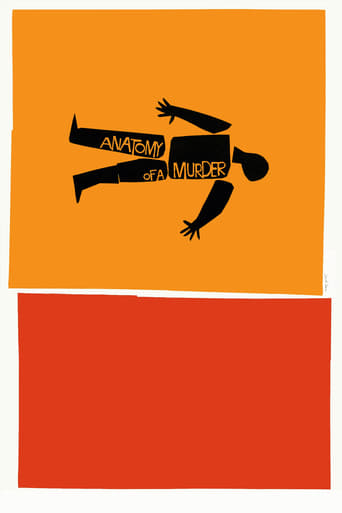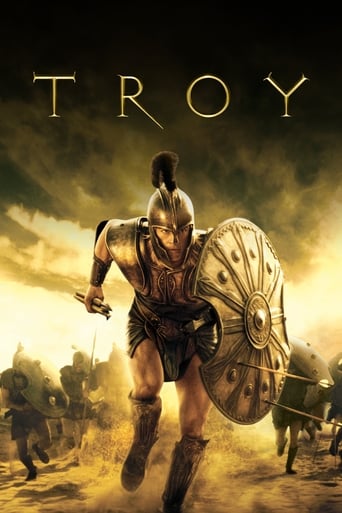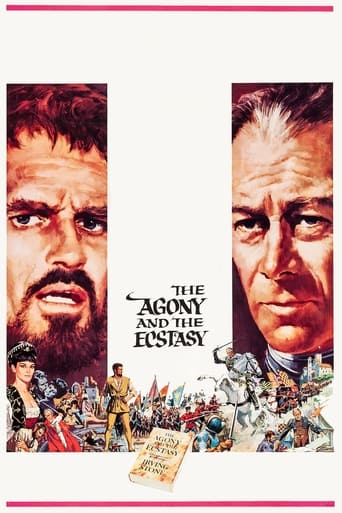
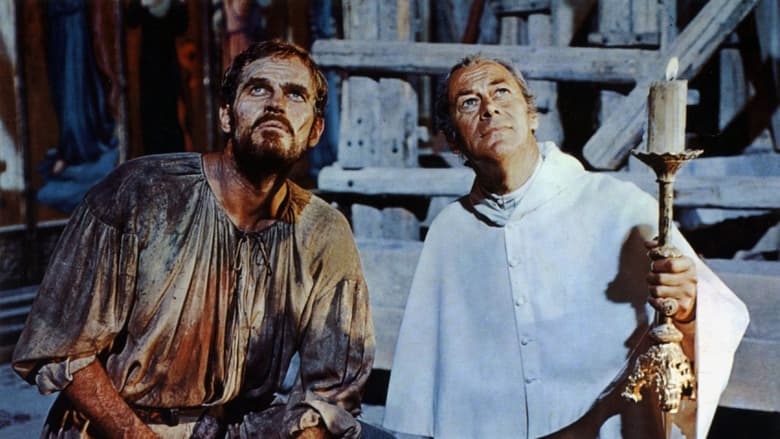
The Agony and the Ecstasy (1965)
During the Italian Renaissance, Pope Julius II contracts the influential artist Michelangelo to sculpt 40 statues for his tomb. When the pope changes his mind and asks the sculptor to paint a mural in the Sistine Chapel, Michelangelo doubts his painting skills and abandons the project. Divine inspiration returns Michelangelo to the mural, but his artistic vision clashes with the pope's demanding personality and threatens the success of the historic painting.
Watch Trailer
Cast
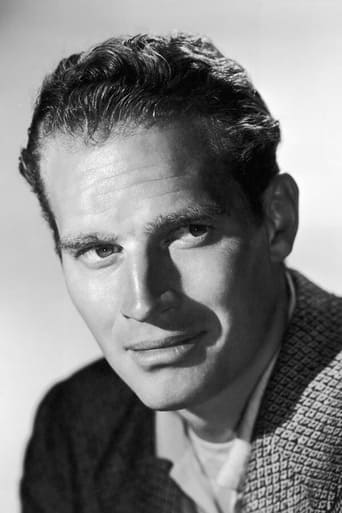
Similar titles
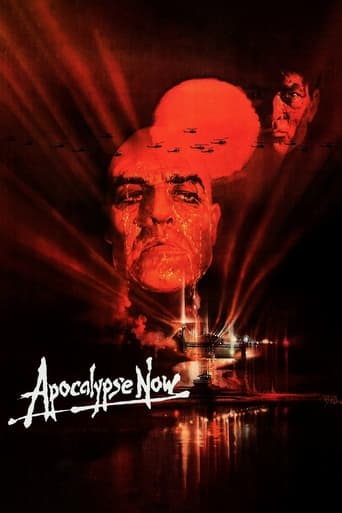
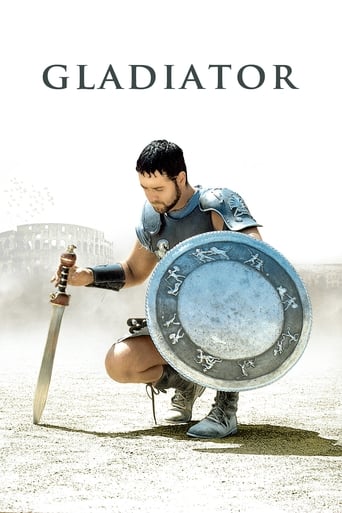


Reviews
The performances transcend the film's tropes, grounding it in characters that feel more complete than this subgenre often produces.
True to its essence, the characters remain on the same line and manage to entertain the viewer, each highlighting their own distinctive qualities or touches.
The thing I enjoyed most about the film is the fact that it doesn't shy away from being a super-sized-cliche;
Actress is magnificent and exudes a hypnotic screen presence in this affecting drama.
Not quite the disaster the critics made it out to be but hardly likely to be remembered among the best of Carol Reed. It was a prestige production done on a grand scale but neither Philip Dunne's screenplay nor, indeed, Irving Stone's original novel were inspirational. The subject, of course, is Michaelangelo's painting of the ceiling of the Sistine Chapel and Charlton Heston, who else, is a hugely miscast Michaelangelo, (he's heterosexual, for starters). He does what he can with the part but the material defeats him. On the other hand, Rex Harrison not only carries the movie but redeems it. He barnstorms his way through the part of Pope Julius II, the man who commissioned Michaelangelo in the first place. He even manages the fanciful dialogue, barking it out as though it were Shakespeare. There's also a decent supporting cast, both British and Italian, with the Italians largely dubbed, but they too are wasted. Does it give us any insight into the man or his work? Absolutely not, but as epics go it's a pleasant enough time-passer.
Already renowned as a master sculptor, Michelangelo is commanded by Pope Julius II to paint the ceiling of his Sistine Chapel, and he reluctantly accepts the commission. Based on Irving Stone's best-selling novel, "The Agony and the Ecstasy" is a thin retelling of the artist's creative struggle and his verbal sparring with the Pope. Carol Reed's lavish production is shamelessly padded with a documentary prologue about Michelangelo's sculpture, an intermission little more than an hour into the movie, exit music, and numerous atmospheric shots that add little but running time to the story. However, the padding and extras provided enough perceived value to warrant a reserved-seat roadshow presentation at higher ticket prices, which was a popular venue for prestige films in the 1950's and 1960's. Unfortunately, this obviously big-budget production exemplifies the old adage that the whole is less than the sum of its parts.Charlton Heston has a granite face and monumental physique that suggests one of Michelangelo's sculptures, and, while he has on-screen presence, his acting range falls short of the demanding role of a tortured artist. Rex Harrison, on the other hand, is outstanding as the warrior pope, a complex man balancing spiritual and worldly ambitions. Fresh from an Academy Award nomination for his Julius Caesar in "Cleopatra" and a second nomination and the Oscar for his Henry Higgins in "My Fair Lady," Harrison deserved a least a third nod for this film. The rest of the cast is adequate, although Diane Cilento, who does the best she can with a thankless role, is little more than a bone thrown to the female audience in what is essentially a male-centric drama. Michelangelo is among the world's most famous historical gay men, and, while Philip Dunne's screenplay alludes to the artist's sexuality, the script blurs the issue and sidesteps a direct confrontation; Cilento's ambiguous relationship with the artist was likely intended to throw off all but the most knowledgeable viewers.Aside from Harrison's performance, "The Agony and the Ecstasy" is worthy viewing as a visual feast. Fresh from Oscar-winning work on "Cleopatra," the Twentieth Century Fox design team of John DeCuir and Jack Martin Smith stunningly recreated the ecclesiastical glory of 16th century Rome. Among other Oscar winners for "Cleopatra" were Vittorio Nino Novarese, whose costumes glow in reds, crimsons, and golds; and Leon Shamroy, whose color cinematography gloriously captures the period detail. A fine score by Alex North, another veteran of "Cleopatra," further enhances the visuals. Carol Reed's adaptation of "The Agony and the Ecstasy" is eye, and some times ear, candy, especially for those interested in art history; the scenes that detail the creation of the Sistine Chapel ceiling are particularly fascinating. However, beyond the visuals and an award-worthy performance by Rex Harrison, the film is thin on drama and weak on historical accuracy.
This movie is a credit to the producers. It shows the Pope of Rome as human, and as a man who understands his weaknesses and God's greatness. I am a Baptist and hence do not hold to Roman Catholic theology. However, it is fair to say that the two main characters, Michelangelo and Pope Julius do a good job of pointing to the bigness of God and the smallness of man.The movie has some very good statements about God and His sovereignty. The Pope in a weak and humble moment is found by Michelangelo kneeling with a candle at the top of the scaffolding under the panel depicting creation. He asks with awe and wonder about how Michelangelo came to the image of God and man. The Pope then stated, "There is God Who created man, and the artist who was moved to paint the image . . . I am merely a Pope." And he meant "merely a Pope." He understood his smallness. At the end the dying Pope says to Michelangelo, "When I stand before God in judgment, I will place this ceiling in the balance against my sins . . . perhaps it will shorten my time in purgatory." Again, I do not hold to purgatory. But the Pope understood that only those things done for the glory of God will last. Good movie and does honor to history, WITHOUT bad language or sexual content. Good family fare.
The story of the rivalry between Pope Julius II and Michelangelo is an epic movie from director Carol Reed, which not only contrasts the lavish life of the Pope with the hardscrabble existence of his famous protégé but also shows the common ground between them - a deep faith. This is early 16th century Italy. Rex Harrison, as the Pope, is a soldier who leads his forces in battle. He believes this is his calling in order to save the Papal States from being overrun by foreigners. He is no 21st century Pope Francis; however, he does appreciate art and the role of great artists to interpret the faith. This explains his relationship with Michelangelo.Rex Harrison dominates every scene he appears in. Harrison is very impressive with his classic voice and an outstanding script and he gives a strong persona to Pope Julius in his long white and red robes. He is a renaissance-warrior pope who has moments when he becomes almost like a kindred spirit of Michelangelo, if only briefly.Julius makes his entrance on a white horse following one of his battles while pieces of bread are thrown to the peasants in the town square. His costumed entourage follow as the people kneel and bless themselves. Overblown definitely; but certainly a grand spectacle. I also was taken by the quarry scenes where stone masons are seen cutting and sculpting marble or workers sawing through it and moving it on pulleys. After first rejecting the idea of painting the Sistine Chapel, Michelangelo comes to embrace it after seeing a vision in the sky that inspired the idea of painting the Creation in the Chapel. The sparring of two strong-willed giants of the early 1500s is a match of forceful arguments; however, because he has the power, Julius is able to have his way. A devout Christian, Michelangelo still did not bend easily to the Pope's will. Later, Michelangelo realizes he needed the pope's determination to force him to finish painting the Sistine Chapel.It is amusing to watch the Pope pass underneath the scaffolding inside the famous chapel as his procession ducks splattering paint, and falling objects. We see Julius chiding the artist for showing disrespect to his cardinals, while defending the frescoes that are being attacked as pagan. Later, we find Julius visiting the bedside of the ailing painter saying that he has been too overbearing and that he will take him off the project, and send him off to his hometown of Florence with a pension while Raphael takes over. This has the intended effect of forcing the painter back to the job. In the end, we see the bond between the artist and the warrior pope whose real legacy might have been that he recognized the talent of the artist Michelangelo, not his role in preventing the sack of Rome. Theirs was more like a troubled father-son relationship. Julius seems to understand the deep faith and timeless quality of Michelangelo's work more than the artist himself who failed to grasp its profound effect on the pope. Julius admitted that he lacked the faith that inspired great art and thus he could not be an artist. Thus, he appreciated it and learned from it.I liked the female lead in the movie, played by Diane Cilento, who had a deep affection for the artist, but it was an unrequited love. Was Michelangelo too consumed with art to be interested in women? It does raise a question, however, about a young man in the prime of life, who is passionate in every other way. We don't know the answer and it hardly seems to matter to the story but it is worth noting. This woman in particular knew his talent and also influenced him to persevere. The movie is one more of Heston's iconic roles drawn from the history of the the Jewish and Christian faiths. But most of all, it is a movie with superb performances by two great actors representing different aspects of Christendom in the early 1500's.




